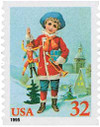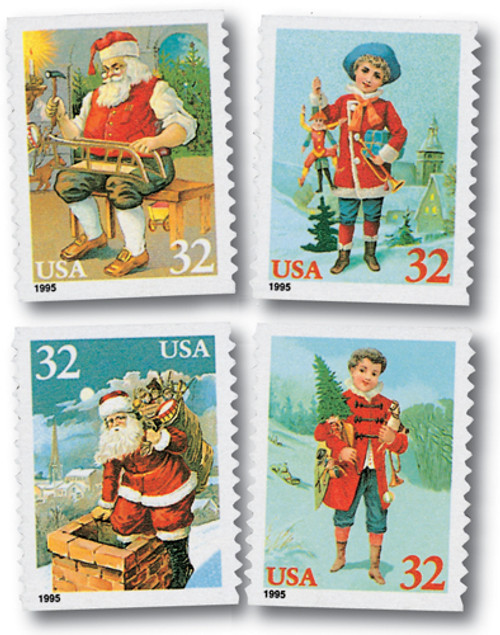
# 3015 - 1995 32c Contemporary Christmas: Child with Jumping Jack, coil
US #3015
1995 Child Holding Jumping Jack
- 1995 contemporary Christmas stamps
- Self-adhesive
- Issued in four formats
Category of Stamp: Commemorative
Set: Christmas series
Value: 32¢, First-class Mail rate
First Day of Issue: September 30, 1995
First Day City: North Pole, New York
Quantity Issued: 495,000,000
Printed by: Avery Dennison
Printing Method: Lithographed
Format: Coils of 5,000
Perforations: Serpentine die cut 11.25
Reason the stamp was issued: This stamp is from a set of four which was issued for the 1995 Christmas mailing season. The stamps highlight Santa Claus and children holding gifts.
About the stamp design: The four images on the stamps are based upon artwork created by unknown Victorian artists. These artists worked for commercial printers and publishers. The original pieces were part of The John Grossman Collection of Antique Images. The chosen images were scanned into a computer and edited. Child Holding Jumping Jack is an example of “scrap.” Scrap were colorful printed and embossed images which children and adults used to decorate holiday objects. They were later collected and preserved in scrapbooks.
Special design details: This set of stamps was the first Christmas stamps issued with no wording other than the denomination and “USA.” Christmas stamps issued in previous years included the word “Greetings.”
About the printing process: This stamp was issued as sheets, booklets, self-adhesive panes, and self-adhesive coils.
First Day City: The First Day of Issue ceremony took place at Santa’s Workshop Rural Postal Substation in the town of North Pole, New York, near Lake Placid. About 1,000 people attended the event. Santa’s Workshop is the oldest continuously run theme park in the US.
Unusual thing about this stamp: John Grossman, who owned the Victorian items used for the stamp images, produced collectables with the same designs as the stamps. These included wrapping paper, tote bags, and note cards.
About the Christmas series: By the early 1960s, the US Post Office was receiving 1,000 letters a year (for several years) asking for a Christmas-themed stamp to frank their holiday mail. The idea was approved and the US issued its first Christmas stamp on November 1, 1962.
The stamp was wildly popular, featuring popular holiday decorations of a wreath and candles. The Post Office Department had expected there would be a great demand for the issue, so they printed 350 million stamps – the largest print run for a special stamp up to that time. Those 350 million stamps sold out quickly, leading the Bureau of Engraving and Printing to produce more stamps – reaching over 860 million by the end of the year.
While the Christmas stamp was very popular, it wasn’t without its detractors. Some didn’t agree with the idea of the post office issuing a stamp honoring a religious holiday. Others wanted Christmas stamps that were more religious. The Post Office would continue to issue Christmas stamps in the coming years that featured the National Christmas Tree, seasonal plants, and an angel in 1965. The angel was considered less controversial because angels are included in many religions, not just Christianity.
In 1966, the Post Office came up with a plan to produce Christmas stamps utilizing classic paintings of the Madonna and Child. These stamps wouldn’t violate the separation of church and state because they were a celebration of culture. On November 1, 1966, they issued the first US Madonna and Child stamp in Christmas, Michigan. The stamp featured the 15th century painting, Madonna and Child with Angels, by Flemish painter Hans Memling.
That stamp was very popular and over 1.1 billion were printed. The same design was used again the following year, however, the 1967 stamp was larger and showed more of the painting. The stamp’s continued popularity led the Post Office to issue another traditional Christmas stamp in 1968, this time picturing the Angel Gabriel. For the 1969 issue, they reverted back to the non-religious theme, with a stamp picturing a painting called Winter Sunday in Norway, Maine.
The Post Office made a big change in 1970. To keep people in both camps happy, they issued one traditional Christmas stamp, picturing a classic painting of the Nativity, plus a block of four picturing Christmas toys. That decision proved popular and they have continued to issue stamps with both traditional and contemporary Christmas themes ever since.
History the stamp represents: Two antique paper items were used to create the design for this stamp. The boy is from original scrap. Color was added to his clothing, which was originally mostly white.
The village scene used as a background is from a picture postcard. In the original image, Santa is coming down a hill and “Merry Christmas” is printed in Russian.
Until the 1850s, toy stores were virtually unheard of, and most toys children received for Christmas were homemade. But the appearance of mass-manufactured toys opened a new market for shopkeepers who piled their counters and shelves high with every imaginable toy – including drums, horns, toy kitchens with real woodburning stoves, china sets, armies of tin soldiers, rocking horses, hoops, jacks, trains, and steamboats.
Each year it seemed Santa produced toys more fabulous than the year before and it wasn’t long before motion and sound appeared in toys. The late 1800s saw an explosion of ingenious toys – guns that fired peas, dogs that jumped through hoops, and baby dolls that cried. These amazingly lifelike clockwork toys, many of which were imported from Europe, delighted young and old alike. But despite all the fantastic creations, brightly painted Noah’s arks remained a favorite throughout the years. Dolls were also popular, and soon they too became elaborate creations with lifelike expressions, real hair, and eyes that opened and closed.
US #3015
1995 Child Holding Jumping Jack
- 1995 contemporary Christmas stamps
- Self-adhesive
- Issued in four formats
Category of Stamp: Commemorative
Set: Christmas series
Value: 32¢, First-class Mail rate
First Day of Issue: September 30, 1995
First Day City: North Pole, New York
Quantity Issued: 495,000,000
Printed by: Avery Dennison
Printing Method: Lithographed
Format: Coils of 5,000
Perforations: Serpentine die cut 11.25
Reason the stamp was issued: This stamp is from a set of four which was issued for the 1995 Christmas mailing season. The stamps highlight Santa Claus and children holding gifts.
About the stamp design: The four images on the stamps are based upon artwork created by unknown Victorian artists. These artists worked for commercial printers and publishers. The original pieces were part of The John Grossman Collection of Antique Images. The chosen images were scanned into a computer and edited. Child Holding Jumping Jack is an example of “scrap.” Scrap were colorful printed and embossed images which children and adults used to decorate holiday objects. They were later collected and preserved in scrapbooks.
Special design details: This set of stamps was the first Christmas stamps issued with no wording other than the denomination and “USA.” Christmas stamps issued in previous years included the word “Greetings.”
About the printing process: This stamp was issued as sheets, booklets, self-adhesive panes, and self-adhesive coils.
First Day City: The First Day of Issue ceremony took place at Santa’s Workshop Rural Postal Substation in the town of North Pole, New York, near Lake Placid. About 1,000 people attended the event. Santa’s Workshop is the oldest continuously run theme park in the US.
Unusual thing about this stamp: John Grossman, who owned the Victorian items used for the stamp images, produced collectables with the same designs as the stamps. These included wrapping paper, tote bags, and note cards.
About the Christmas series: By the early 1960s, the US Post Office was receiving 1,000 letters a year (for several years) asking for a Christmas-themed stamp to frank their holiday mail. The idea was approved and the US issued its first Christmas stamp on November 1, 1962.
The stamp was wildly popular, featuring popular holiday decorations of a wreath and candles. The Post Office Department had expected there would be a great demand for the issue, so they printed 350 million stamps – the largest print run for a special stamp up to that time. Those 350 million stamps sold out quickly, leading the Bureau of Engraving and Printing to produce more stamps – reaching over 860 million by the end of the year.
While the Christmas stamp was very popular, it wasn’t without its detractors. Some didn’t agree with the idea of the post office issuing a stamp honoring a religious holiday. Others wanted Christmas stamps that were more religious. The Post Office would continue to issue Christmas stamps in the coming years that featured the National Christmas Tree, seasonal plants, and an angel in 1965. The angel was considered less controversial because angels are included in many religions, not just Christianity.
In 1966, the Post Office came up with a plan to produce Christmas stamps utilizing classic paintings of the Madonna and Child. These stamps wouldn’t violate the separation of church and state because they were a celebration of culture. On November 1, 1966, they issued the first US Madonna and Child stamp in Christmas, Michigan. The stamp featured the 15th century painting, Madonna and Child with Angels, by Flemish painter Hans Memling.
That stamp was very popular and over 1.1 billion were printed. The same design was used again the following year, however, the 1967 stamp was larger and showed more of the painting. The stamp’s continued popularity led the Post Office to issue another traditional Christmas stamp in 1968, this time picturing the Angel Gabriel. For the 1969 issue, they reverted back to the non-religious theme, with a stamp picturing a painting called Winter Sunday in Norway, Maine.
The Post Office made a big change in 1970. To keep people in both camps happy, they issued one traditional Christmas stamp, picturing a classic painting of the Nativity, plus a block of four picturing Christmas toys. That decision proved popular and they have continued to issue stamps with both traditional and contemporary Christmas themes ever since.
History the stamp represents: Two antique paper items were used to create the design for this stamp. The boy is from original scrap. Color was added to his clothing, which was originally mostly white.
The village scene used as a background is from a picture postcard. In the original image, Santa is coming down a hill and “Merry Christmas” is printed in Russian.
Until the 1850s, toy stores were virtually unheard of, and most toys children received for Christmas were homemade. But the appearance of mass-manufactured toys opened a new market for shopkeepers who piled their counters and shelves high with every imaginable toy – including drums, horns, toy kitchens with real woodburning stoves, china sets, armies of tin soldiers, rocking horses, hoops, jacks, trains, and steamboats.
Each year it seemed Santa produced toys more fabulous than the year before and it wasn’t long before motion and sound appeared in toys. The late 1800s saw an explosion of ingenious toys – guns that fired peas, dogs that jumped through hoops, and baby dolls that cried. These amazingly lifelike clockwork toys, many of which were imported from Europe, delighted young and old alike. But despite all the fantastic creations, brightly painted Noah’s arks remained a favorite throughout the years. Dolls were also popular, and soon they too became elaborate creations with lifelike expressions, real hair, and eyes that opened and closed.










